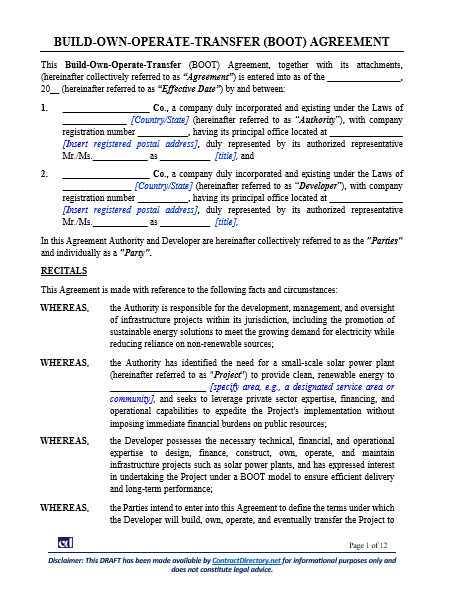Estimated reading time: 2 minutes
A Build-Own-Operate-Transfer Agreement (B.O.O.T.) is a project delivery method where a private entity designs, builds, owns, and operates an infrastructure project for a set period, recouping its investment by charging users or receiving government payments, before finally transferring the asset to the public sector.
B.O.O.T. contracts are common for large-scale infrastructure like toll roads, airports, and power plants, allowing governments to leverage private sector expertise and capital while retaining ownership of the facility long-term.

B.O.O.T. Agreement is a powerful Public-Private Partnership (PPP) tool for infrastructure development. This agreement enables private developers to design, finance, build, own, and operate projects for a fixed concession period, after which they are transferred to public authorities.
B.O.O.T. Agreements distribute risks efficiently and provide a framework for sustainable and timely project delivery.
Purpose and Structure of BOOT Agreement
The Build-Own-Operate-Transfer Agreement (B.O.O.T) defines how the developer finances, constructs, and manages the project. It specifies concession periods, ownership rights, and obligations during construction and operation.
The agreement is critical because it sets clear terms for performance, timelines, and transfer obligations. The structure includes recitals, definitions, scope of work, payment clauses, tax obligations, performance guarantees, insurance, and termination provisions.
Scope of Work and Developer Obligations
The scope of work outlines design, engineering, procurement, construction, and commissioning activities. Developers must comply with specifications, legal standards, and environmental regulations.
The B.O.O.T. Agreement requires developers to provide performance bonds, maintain insurance, and share revenues with the authority. Clear milestones, including commencement and completion dates, ensure accountability.
Transfer and Risk Allocation
At the end of the concession period, the project transfers to the authority free of liens and in operational condition. Risk allocation is a key feature of every B.O.O.T. Agreement, protecting public interest while incentivizing private investment. Dispute resolution clauses, confidentiality provisions, and governing law sections ensure smooth handover and long-term project sustainability.
Note: You may also explore related models, such as the following agreements, which share similarities with B.O.O.T. Agreements but differ in ownership and transfer structures. These alternatives offer governments and private investors additional flexibility in structuring infrastructure partnerships.:
- Build-Operate-Transfer (B.O.T)
- Build-Own-Operate Contract (B.O.O.)
- Build-Lease-Operate-Transfer Agreement (B.L.O.T)
- Public–Private Partnership Project Agreement (PPP)
- Ownership Transfer Acknowledgement
References:
- International Renewable Energy Agency – PPP Models
- World Bank PPP Knowledge Lab
- UNIDO Guidelines for B.O.O.T Projects
has been added to your cart!
have been added to your cart!



